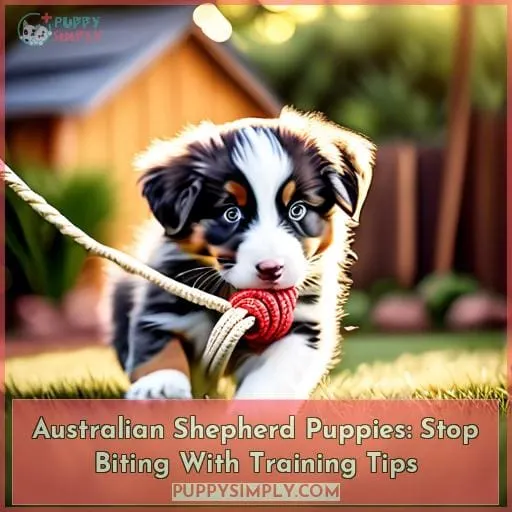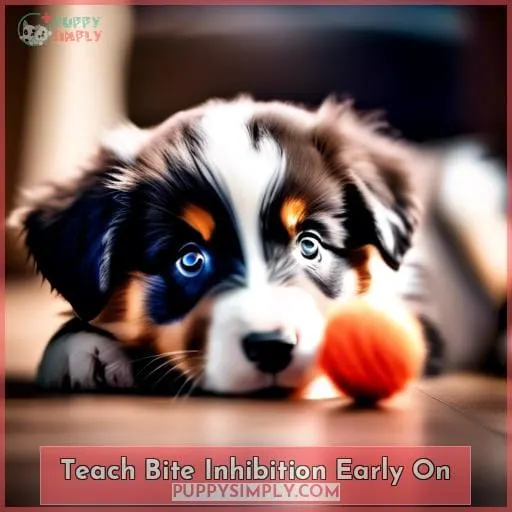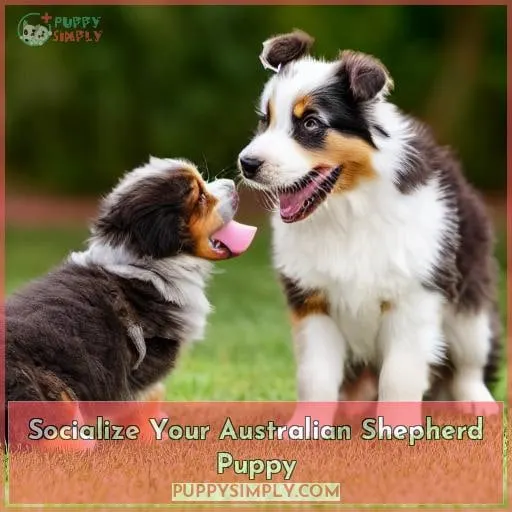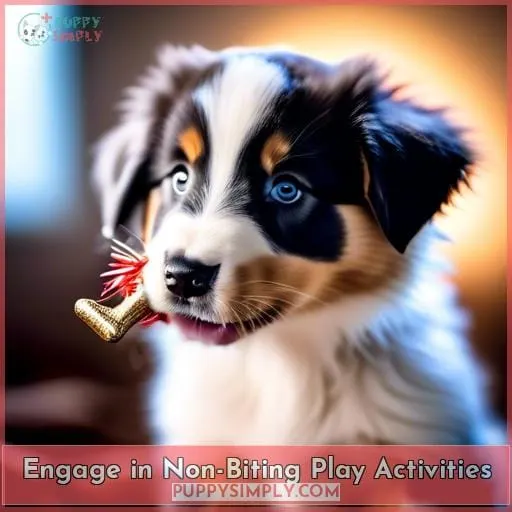This site is supported by our readers. We may earn a commission, at no cost to you, if you purchase through links.
 Are you struggling with an Australian Shepherd puppy that seems to have turned your hands and feet into their favorite chew toys? Understanding and curbing this behavior requires a blend of knowledge, patience, and consistent training strategies.
Are you struggling with an Australian Shepherd puppy that seems to have turned your hands and feet into their favorite chew toys? Understanding and curbing this behavior requires a blend of knowledge, patience, and consistent training strategies.
Australian Shepherds are intelligent, energetic dogs with a natural inclination to bite due to their herding instincts and the teething phase. However, with the right approach, you can guide your puppy through this phase, ensuring they grow into well-behaved adult dogs.
This article delves into proven tips to stop your Australian Shepherd puppy from biting, from understanding the root causes to implementing effective training techniques. Let’s embark on this journey to transform those painful nips into gentle behavior, enhancing the bond between you and your furry friend.
Australian Shepherd puppies typically begin to stop biting around five months of age as their jaws strengthen and they develop more adult teeth. To stop biting, consistent training is essential, such as using the ‘Ouch! Method’ to teach bite inhibition and redirecting the puppy’s attention to toys or using ‘Shunishment’ to withdraw attention when biting occurs.
Table Of Contents
- Key Takeaways
- Understand Why an Australian Shepherd Puppy Bites
- Offer Appropriate Chew Toys
- Teach Bite Inhibition Early On
- Consistency is Crucial
- Socialize Your Australian Shepherd Puppy
- Engage in Non-Biting Play Activities
- Implement “Time-Out” Periods
- Reward Positive Behaviors
- If Needed, Seek Expert Assistance
- Training Techniques and Tools
- Frequently Asked Questions (FAQs)
- How can I manage my Australian Shepherd’s biting behavior if it seems to be linked to their strong herding instincts?
- Are there specific dietary considerations or supplements that can help reduce aggressive or nipping behavior in Australian Shepherd puppies?
- How do I safely introduce my Australian Shepherd puppy to other pets in the home to minimize biting incidents?
- What are the signs that my Australian Shepherd’s biting is not just playful but may indicate a deeper behavioral issue?
- Can certain environmental factors or changes in the household contribute to an increase in biting behavior, and how can these be addressed?
- Conclusion
Key Takeaways
- Australian Shepherd puppies typically begin to stop biting around 5 months of age as they develop more adult teeth and stronger jaws, making it crucial to teach bite inhibition before this age.
- Bite inhibition can be taught using methods such as mimicking a littermate’s yelp to provide immediate feedback and consistently discouraging biting during play.
- Managing biting behavior includes offering appropriate chew toys, socializing the puppy, engaging in non-biting play activities, and implementing time-out periods to reward positive behaviors.
- If biting persists, it may be necessary to seek professional training or advice from herding breed specialists to address deeper behavioral issues or anxiety-related aggression.
Understand Why an Australian Shepherd Puppy Bites
Australian Shepherd puppies, known for their intelligence and energy, often express their curiosity and herding instincts through biting. This behavior, while natural, requires understanding and management to ensure it doesn’t become problematic.
Initially, biting is a way for puppies to explore their environment and relieve the discomfort of teething, which typically occurs between two to seven months of age. Additionally, the herding instinct in Australian Shepherds can manifest as nipping, especially at moving objects or people, a trait deeply ingrained from their history as livestock herders.
Recognizing these behaviors as part of their development and instinctual responses, rather than aggression, is crucial in addressing and modifying this behavior through consistent training and positive reinforcement.
Natural Behavior and Teething
Understanding why your Australian Shepherd puppy bites is the first step in addressing the behavior.
- Exploration through Mouth: Puppies, including Australian Shepherds, use their mouths to explore their environment, which is a critical part of their cognitive development.
- Teething Discomfort: As their teeth grow, puppies experience discomfort and often seek relief by chewing on objects, which can include your hands or clothing.
- Attention-Seeking Biting: Biting can also be a way for puppies to get your attention; it’s not necessarily a sign of aggression but rather a form of communication.
- Non-Biting Play Activities: Engaging your puppy in play that doesn’t involve their teeth is essential. Providing chew toys can help satisfy their need to bite in a non-destructive way.
Herding Instinct
Continuing from the natural exploratory biting of your Australian Shepherd puppy, let’s delve into their herding instinct. This breed’s lineage is steeped in the role of livestock management, which often involves nipping to direct animals.
Understanding this can inform your training approach, ensuring it aligns with their instinctual behaviors. Early socialization and positive reinforcement are key in shaping desirable behaviors, while environmental management can help mitigate unwanted nipping.
Professional guidance may be beneficial if standard training methods are insufficient.
| Herding Instinct Aspect | Training Consideration |
|---|---|
| Breed Tendencies | Tailor training to accommodate the Australian Shepherd’s natural herding behaviors. |
| Early Socialization | Expose your puppy to various situations early to prevent fear-based biting. |
| Positive Reinforcement | Reward non-nipping behavior to reinforce good habits. |
| Environmental Management | Structure the puppy’s environment to reduce stimuli that trigger nipping. |
Offer Appropriate Chew Toys
To mitigate your Australian Shepherd puppy’s biting behavior, it’s imperative to provide them with chew toys that are appropriate for their size and developmental stage.
These toys not only offer relief during the teething phase but also serve as suitable alternatives to biting people or household items.
Your selection of chew toys should cater to their need to gnaw, which can help redirect their biting tendencies in a positive manner.
For Teething Relief
To provide teething relief for your Australian Shepherd puppy, it’s essential to select chew toys that cater to their developmental stage. Chew toys not only offer a safe outlet for their natural chewing instincts but also soothe their sore gums.
Opt for toys that are of appropriate size and durability for your puppy’s age, ensuring they’re neither too small to pose a choking hazard nor too hard to damage their developing teeth. Frozen washcloths or toys can offer additional comfort, as the cold helps to numb the discomfort of teething.
Incorporate these toys into playtime to serve as a distraction from the urge to nip or chew on inappropriate items. Always supervise your puppy with these toys to prevent any accidents and replace them as needed to maintain safety.
Size and Age-Appropriate Toys
Continuing from the discussion on teething relief, it’s imperative to select chew toys that are tailored to your Australian Shepherd’s size and age. These toys serve as safe alternatives to inappropriate chewing and are instrumental in monitoring the teething process.
For optimal bite inhibition, it’s crucial to provide a variety of chew toys that not only cater to your puppy’s urge to gnaw but also promote dental health. As your Aussie grows, regularly assess the suitability of their toys to ensure they remain appropriate for their developing teeth and jaw strength.
Engaging with a range of chew toys can significantly aid in managing your puppy’s biting behavior, offering them a constructive outlet for their natural instincts.
Teach Bite Inhibition Early On
To instill bite inhibition in your Australian Shepherd puppy, it’s essential to provide immediate feedback during play, akin to the natural responses they’d receive from their littermates.
If your puppy bites too hard, respond with a high-pitched yelp or an emphatic ow to convey that the bite was painful.
Consistently practicing this technique, coupled with positive reinforcement for gentle play, will help your puppy understand the limits of acceptable mouthing behavior.
Mimic Littermate Yelp
To effectively teach your Australian Shepherd puppy bite inhibition, it’s essential to understand and utilize littermate dynamics.
When a puppy bites too hard during play, their siblings will often yelp, signaling pain and stopping the interaction. Emulate this vocal communication by letting out a high-pitched ouch! or yelp when your puppy nips too hard.
This response should capture their attention and momentarily stop their behavior, teaching them about pain tolerance and regulating their bite strength.
Consistently reacting in this way when they apply too much pressure will help your puppy learn play bite inhibition, ensuring that their herding instinct doesn’t lead to nipping at your nose or other unwanted behaviors.
Immediate Feedback During Play
Continuing from the concept of mimicking a littermate’s yelp to teach bite inhibition, it’s crucial to provide immediate feedback during play. This teaches your Australian Shepherd puppy the acceptable play strength and helps them understand the consequences of their mouthing behavior.
- Utilize verbal cues like Ouch to indicate when a bite is too hard, simulating the feedback they’d receive from a littermate.
- Immediately withdraw attention following a hard bite, reinforcing that nipping leads to the loss of playtime.
- Consistently apply the leave it or ouch method to help your puppy understand the pressure method of bite inhibition.
- Reward softer mouthing with praise or treats, ensuring that positive behaviors are reinforced over nipping.
The consistency importance in these interactions can’t be overstated; it’s the foundation of effective training. By providing immediate feedback, you’re employing a form of shunishment that clearly communicates to your puppy the behaviors that will result in continued play and attention.
Consistency is Crucial
To effectively curb your Australian Shepherd puppy’s biting habits, it’s essential to maintain uniformity in the family’s response to the behavior.
Avoid engaging in games that might inadvertently encourage biting, such as rough play or tug-of-war, which can send mixed signals to your pup.
Consistent, clear communication and reactions to biting from all household members will help your puppy understand the boundaries and rules, fostering a non-biting environment.
Uniform Reactions From All Family Members
Continuing from the importance of teaching bite inhibition, it’s crucial that all family members provide uniform reactions to your Australian Shepherd’s nipping.
Consistent training across the household sets clear boundaries, ensuring your pup isn’t receiving mixed messages.
When your pup nips, a unified response from family members—ignoring the behavior or offering a firm no—reinforces the lesson that nipping is unacceptable.
Their expertise can offer tailored strategies and reinforce training with positive reinforcement, setting your pup on the path to better behavior.
Avoid Games Encouraging Biting
To effectively manage and reduce nipping behavior in Australian Shepherd puppies, it’s essential to adopt a structured and comprehensive approach that addresses the root causes and provides consistent training and feedback.
-
Natural Exploration: Puppies, including Australian Shepherds, use their mouths to explore the world. Nipping is a part of their natural behavior during play and teething phases.
-
Non-Aggressive Intent: It’s crucial to recognize that nipping doesn’t necessarily indicate aggression. Puppies often nip to seek attention or express excitement.
-
Consistent Commands: Implement consistent training sessions to teach basic commands like ‘sit’ or ‘down’ to distract puppies from nipping behaviors.
-
Preemptive Redirection: Anticipate nipping instances and redirect the puppy’s attention with toys or treats to discourage the behavior before it occurs.
-
Positive Reinforcement: Reward non-nipping behavior with treats, praise, or playtime to reinforce desired actions. Avoid reinforcing nipping by not providing rewards immediately after a nip.
-
Early Socialization: Expose puppies to various environments, animals, and people to make them comfortable with being touched and reduce fear-based biting.
-
Regular Handling: Gently handle the puppy regularly to build their tolerance for touch, using treats to create positive associations with handling.
-
Appropriate Play: Engage in play activities that don’t encourage nipping, such as fetch or agility-based games, to channel the puppy’s energy positively.
-
Physical Exercise: Provide ample physical exercise to help reduce excess energy that might contribute to nipping behavior.
-
Seek Expert Advice: If nipping persists despite consistent training and efforts, consider seeking advice or training from professionals experienced with herding breeds like Australian Shepherds.
By organizing strategies into these comprehensive groups, owners can adopt a structured approach to managing and reducing nipping behavior in Australian Shepherd puppies. This approach addresses the behavior from multiple angles, including understanding the puppy’s natural instincts, providing consistent training and feedback, ensuring proper socialization and handling, engaging in appropriate play and exercise, and seeking professional assistance when necessary.
Socialize Your Australian Shepherd Puppy
To effectively manage your Australian Shepherd puppy’s biting behavior, it’s essential to expose them to a variety of environments and ensure they’re comfortable with being touched.
Early socialization can help your puppy become accustomed to different stimuli and reduce fear-based biting. Introduce your puppy to new sights, sounds, and experiences in a controlled manner, reinforcing calm behavior with treats and praise.
Regular handling and gentle touch can build their tolerance and create positive associations, making them less likely to nip when excited or during play.
Exposure to Various Environments
Continuing from the importance of consistent reactions to biting, let’s delve into the significance of socialization for your Australian Shepherd puppy. Socialization isn’t merely about exposure to different environments; it’s a structured approach to managing your puppy’s experiences to ensure they’re positive and contribute to their overall behavioral development.
- Introduce your puppy to a variety of environments, such as parks, pet-friendly stores, and quiet streets, to foster adaptability and reduce visual sensitivity.
- Enroll in a puppy class for supervised playtime, which can help with generalization of good behaviors around other dogs and people.
- Practice resource control during socialization to prevent issues like resource guarding, ensuring your puppy learns to share attention and toys.
Socialization is a critical component in mitigating the herding instincts of your Australian Shepherd, allowing them to interact calmly and confidently in diverse settings.
Comfort With Being Touched
As you continue to socialize your Australian Shepherd puppy, it’s essential to ensure they’re comfortable with being touched. This early training fosters touch tolerance and sets the stage for calm interactions throughout their life.
It’s not just about preventing nipping; it’s about preparing them for a lifetime of positive experiences with humans and other animals.
| Step | Action | Goal |
|---|---|---|
| 1 | Handle gently | Build trust and reduce fear |
| 2 | Introduce an indoor leash | Create a controlled teaching moment |
| 3 | Engage in training games | Reinforce positive touch experiences |
| 4 | Implement time-out periods | Teach consequences for inappropriate nipping |
| 5 | Seek expert assistance if needed | Ensure professional guidance for persistent issues |
By consistently applying these steps, you’ll help your puppy learn that human interaction is safe and enjoyable. This is crucial for their development and will aid in preventing nipping behaviors associated with discomfort or fear.
Remember, the goal is to socialize your puppy in a way that they not only tolerate touch but also associate it with positive reinforcement and love.
Engage in Non-Biting Play Activities
To effectively manage and reduce nipping behavior in Australian Shepherd puppies, engaging them in non-biting play activities is crucial.
Channeling their energy positively through play that doesn’t encourage nipping, such as fetch or puzzle toys, can significantly help.
These activities not only provide mental stimulation but also teach puppies appropriate ways to interact, diverting their natural tendencies away from nipping behaviors.
Channel Energy Positively
Channeling your Australian Shepherd puppy’s boundless energy into positive outlets is crucial for preventing nipping and biting behaviors.
- Exercise: Incorporate daily activities like leash walking and fetch to burn off excess energy, reducing the likelihood of nipping as a form of entertainment.
- Herding Games: Utilize their natural herding instinct in controlled games that mimic these behaviors without encouraging biting.
- Socialization: Expose your puppy to various environments and beings to enhance their comfort and reduce anxiety-driven nipping.
- Enrichment: Offer mental stimulation through puzzle toys and training sessions to keep their minds engaged and focused away from nipping.
- Consistency: Maintain a consistent approach in all interactions and training efforts to reinforce the expectation that nipping is unacceptable behavior.
By focusing on these areas, you can help your Australian Shepherd puppy develop into a well-behaved and content companion.
Play That Doesn’t Encourage Nipping
To effectively manage and reduce nipping behavior in Australian Shepherd puppies, it’s crucial to engage them in play activities that don’t encourage this undesirable behavior.
Tug-of-war, when played with clear rules, can be a beneficial game. It’s essential to ensure that the game doesn’t escalate into aggressive behavior by maintaining control and stopping the game if the puppy becomes too excited or begins to nip.
Using commands like drop can teach the puppy to release the toy on command, reinforcing good behavior without encouraging nipping.
Additionally, incorporating games that focus on mental stimulation rather than physical contact, such as chasing games that use toys instead of human hands or feet, can help redirect the puppy’s energy and reduce the likelihood of nipping.
The leave it command is another valuable tool, teaching puppies self-control and to ignore potential nipping targets.
Implementing these strategies with consistency and patience will help curb nipping behavior while providing the puppy with appropriate outlets for their energy and natural behaviors.
Implement “Time-Out” Periods
To effectively manage your Australian Shepherd’s nipping behavior, it’s essential to implement time-out periods as a disciplinary measure.
When your puppy nips, immediately signal that the behavior is unacceptable by saying Ouch! in a high-pitched voice. Then, remove yourself from the situation by leaving the room for a brief period.
This action teaches your puppy that biting results in the cessation of play and attention, reinforcing that gentle interaction is the only way to maintain your presence.
Consistently applying this strategy helps your puppy learn impulse control and the appropriate use of their mouth during interactions.
Teach Biting Stops Playtime
When your Australian Shepherd puppy nips, promptly say Ouch! and ignore them, enforcing a brief time out.
Consistently redirect their behavior to appropriate toys, reinforcing the leave it command. Apply gentle pressure to the mouth if needed, reinforcing the law and order of play.
Positive reinforcement for calm behavior ensures they learn nipping is unacceptable.
Use of Time-Out for Nipping
When addressing your Australian Shepherd’s nipping behavior, it’s essential to implement time-out periods effectively. If your pup begins to nip, it’s crucial to respond immediately. Ignoring the puppy by turning into a lamppost and ceasing all movement can be an effective deterrent, as many puppies are seeking the resistance provided by your reactions.
Utilizing the ouch! method, where you express pain through a verbal cue, can also communicate that their behavior is unacceptable. However, if this incites more nipping, it may be necessary to employ the leave it method, teaching your puppy to focus on something other than nipping.
In cases where verbal cues are insufficient, the pressure method can be applied, where gentle pressure is used to discourage biting. However, this should be done with caution and proper technique to avoid any negative associations or increased excitement that could exacerbate the nipping.
Shunishment, or withholding attention, reinforces the idea that nipping leads to isolation and a loss of interaction, which is a powerful lesson for social animals like dogs.
For teething puppies, providing appropriate chew toys can offer relief and a suitable outlet for their chewing needs. It’s important to supervise these activities to ensure safety and to redirect your puppy’s attention from nipping to chewing on these toys.
If these methods don’t yield results, consider using a leash to manage and correct behavior more directly. Tethering to furniture can create teachable moments, allowing you to leave the room and reinforce the consequence of lost attention when nipping occurs.
Remember, consistency and patience are key, and if biting persists, seeking professional training assistance, especially from those experienced with herding breeds, is advisable.
Reward Positive Behaviors
To effectively manage and reduce nipping behavior in Australian Shepherd puppies, it’s crucial to reward positive behaviors. This approach involves offering treats, praise, or additional playtime to encourage non-nipping actions.
By focusing on reinforcing desirable behavior rather than solely trying to eliminate unwanted actions, you create a positive learning environment for your puppy. This method not only helps in curbing nipping but also strengthens the bond between you and your puppy, making training a more enjoyable experience for both.
Treats, Praise, or Playtime
To effectively reward your Australian Shepherd puppy’s positive behaviors, employ distraction techniques and positive reinforcement. When they choose not to nip, immediately acknowledge their restraint with treats or favorite toys.
During interactive play, use the leave it method to teach impulse control, offering treat alternatives when they obey. If they nip, apply the ouch method, expressing discomfort to signal inappropriate behavior.
For persistent nipping, the pressure method—gentle pressure on the snout accompanied by a firm no—can discourage the habit.
Encourage Non-Nipping Behavior
To encourage non-nipping behavior in your Australian Shepherd puppy, focus on redirection and positive reinforcement. When your pup approaches with the intent to nip, redirect them to perform an alternative behavior such as sitting or hand targeting.
Reward these behaviors with a treat toss, which not only reinforces the desired action but also provides a physical exercise as they chase the treat. This method effectively replaces the nipping behavior with a more acceptable one, leveraging the power of behavior management.
Ignoring the puppy briefly when they nip can also be a useful strategy. Known as the ouch method, it teaches that nipping leads to a loss of attention. Consistent training across all household members is crucial to avoid mixed signals and confusion for the puppy.
Additionally, ensure your puppy has access to chew toys for teething relief, and consider the leave it method to further instill impulse control.
If these strategies don’t lead to improvement, the pressure method can be used to reinforce your commands without resorting to harshness. For persistent issues, seeking professional training, especially from those experienced with herding breeds, may be necessary to address the behavior effectively.
If Needed, Seek Expert Assistance
If your Australian Shepherd puppy’s biting behavior persists despite your best efforts, it’s time to consider seeking expert assistance.
Professionals with advanced degrees in behavioral science or veterinary medicine have the knowledge and experience to offer scientifically-backed strategies for managing and modifying this behavior.
They can provide tailored advice and training techniques specific to herding breeds, ensuring your puppy grows into a well-behaved adult.
Professional Training for Persistent Biting
When dealing with persistent biting in Australian Shepherd puppies, seeking the guidance of professional trainers can be invaluable. These experts create structured environments that foster learning and address underlying causes of unwanted behaviors.
They utilize tools such as indoor leashes and tethering to manage and correct actions, ensuring consistency across various situations—a process known as generalization. A professional trainer can also identify any emotional issues that may contribute to biting and work with a veterinarian to address them.
This collaborative approach is essential for puppies who continue to nip despite previous training efforts.
Advice From Herding Breed Specialists
If biting behavior persists despite your best efforts, it’s time to consult herding breed specialists. These experts understand the breed characteristics of Australian Shepherds, including their herding behavior and the developmental stages of their jaw strength and adult teeth.
They can offer redirection techniques tailored to your Aussie’s instincts, ensuring training generalization across various contexts. With a firm resolve and a confident attitude, you’ll learn to manage behavioral patterns effectively.
Training equipment may be recommended to aid in this process, but always with the goal of reinforcing positive behaviors without intimidation or fear.
Training Techniques and Tools
To effectively manage your Australian Shepherd’s biting behavior, consider incorporating indoor leash and tethering techniques within a structured training environment.
By tethering your dog in a family area, you can safely distance yourself when he exhibits unwanted nipping, reinforcing that this behavior leads to a loss of attention and interaction.
This method, combined with consistent training sessions, can significantly reduce biting incidents and help your Australian Shepherd learn to control his impulses.
Use of Indoor Leash and Tethering
When transitioning from seeking expert assistance for persistent biting in Australian Shepherd puppies, it’s crucial to explore practical training techniques and tools, such as the use of an indoor leash and tethering.
This approach isn’t merely about restraint but is a strategic method to instill discipline and manage behavior effectively. By tethering your puppy with a leash to a stable object like a table leg, you create a controlled environment where the puppy can learn the consequences of nipping or biting.
This method also facilitates teachable moments, allowing for immediate correction and guidance.
The indoor leash serves as a management tool, enabling you to quickly intervene before a nip turns into a bite, thus reinforcing desired behavior through consistent, focused training sessions. It’s essential to integrate mental stimulation into these sessions to keep your Australian Shepherd engaged and to foster impulse control.
Online dog training courses can offer additional strategies for leveraging tools like leashes for training, emphasizing the importance of a structured training environment that caters to the unique needs of high-energy breeds like Australian Shepherds.
This approach not only addresses the immediate issue of nipping but also contributes to the overall well-being and development of your puppy, ensuring they grow into well-adjusted, obedient adult dogs.
Structured Training Environment
To effectively manage and reduce nipping behavior in Australian Shepherd puppies, a structured approach that encompasses understanding their behavior, consistent training, appropriate play, socialization, and professional guidance if needed, is essential.
-
Natural Exploration and Teething: Puppies explore their environment with their mouths, which includes nipping as part of play and teething.
-
Herding Instinct: Australian Shepherds have a strong herding instinct that may contribute to nipping behavior.
-
Non-Aggressive Communication: Nipping is a form of communication and doesn’t necessarily indicate aggression.
-
Consistent Training: Teaching basic commands like ‘sit’ or ‘down’ can help distract puppies from nipping.
-
Bite Inhibition: Teaching bite inhibition through mimicking a littermate’s yelp when bitten too hard provides immediate feedback.
-
Use of Training Tools: Implementing tools like leashes and tethers within a structured training environment can manage and correct behavior.
-
Appropriate Play: Engage in play that doesn’t encourage nipping, such as controlled tug-of-war, and provide ample physical exercise.
-
Redirecting Attention: Redirect the puppy’s attention with toys or treats before they nip.
-
Chew Toys for Teething: Offer a variety of chew toys for teething relief and to provide a safe alternative to nipping.
-
Early Socialization: Socialize puppies early to get them comfortable with being touched and exposed to various environments.
-
Handling and Tolerance: Regularly handle the puppy to build their tolerance for touch, using treats to create positive associations.
-
Seeking Expert Assistance: If nipping persists, consider seeking advice from professionals experienced with herding breeds for tailored training strategies.
By organizing these strategies into comprehensive groups, owners can adopt a structured and holistic approach to managing and reducing nipping behavior in Australian Shepherd puppies. This approach not only addresses the immediate behavior but also considers the underlying causes and the puppy’s overall well-being.
Frequently Asked Questions (FAQs)
How can I manage my Australian Shepherd’s biting behavior if it seems to be linked to their strong herding instincts?
To manage your Australian Shepherd’s biting, linked to their herding instincts, halt movement and avoid eye contact when they nip.
Reward calmness post-behavior. Recognize pre-nip signs; redirect with commands or toys.
Consistent, gentle corrections and positive reinforcement are key.
Are there specific dietary considerations or supplements that can help reduce aggressive or nipping behavior in Australian Shepherd puppies?
To keep your Australian Shepherd puppy from biting off more than they can chew, consider dietary adjustments and supplements.
Introducing a balanced diet with a focus on low-protein foods and tryptophan supplements can help stabilize mood and reduce aggression.
Ensure carbohydrates don’t exceed 35% of their diet to avoid hyperactivity.
Additionally, omega-3 fatty acids, particularly DHA, are crucial for cognitive development and can be supplemented to support brain health and behavior.
How do I safely introduce my Australian Shepherd puppy to other pets in the home to minimize biting incidents?
Introduce your Australian Shepherd puppy to other pets gradually in a controlled, calm environment. Reward positive interactions to reinforce good behavior and minimize biting incidents.
This approach helps the puppy feel safe and secure while learning to socialize with other animals effectively. By creating a positive association with other pets, you can encourage friendly and respectful behavior in your Australian Shepherd.
Remember, patience and consistency are key when introducing new experiences to your puppy.
What are the signs that my Australian Shepherd’s biting is not just playful but may indicate a deeper behavioral issue?
Signs that your Australian Shepherd’s biting may indicate a deeper behavioral issue include aggression not related to herding, such as biting out of fear, frustration, or guarding behavior.
Watch for unprovoked aggression or biting that escalates despite training.
Can certain environmental factors or changes in the household contribute to an increase in biting behavior, and how can these be addressed?
Environmental changes and household dynamics can indeed exacerbate biting in Australian Shepherds.
Address these by maintaining routine, providing mental stimulation, and ensuring consistent, calm interactions with the puppy.
Conclusion
Embarking on the journey with your Australian Shepherd puppy, remember that the path to curbing their biting behavior is paved with understanding, patience, and consistent training.
Like a shepherd guiding their flock with expertise and care, you too can guide your puppy away from their nipping tendencies. By understanding the roots of their behavior, offering appropriate outlets for their energy, and reinforcing positive behaviors, you’re setting the stage for a harmonious relationship.
















